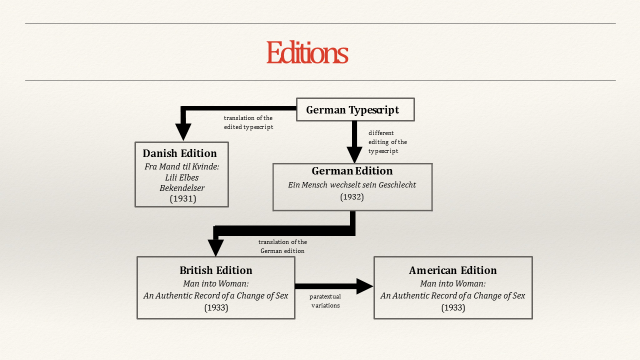Publication History
In March 1930 Danish artist Einar Wegener entered Magnus Hirschfeld’s Institute for Sexual Science (Institut für Sexualwissenschaft) in Berlin, to be interviewed, examined, and photographed before embarking on a series of surgeries that, according to the thinking of the day, would transform him into a woman. Man into Woman (1933) is the life narrative of Lili Ilse Elvenes, popularly known as Lili Elbe and considered by some scholars (and by the narrative itself) to be the first person to undergo what was then called genital transformation surgery (Genitalumwandlung). Elbe’s life story, initially published in 1931 as Fra Mand til Kvinde [From Man into Woman], is the first full-length narrative of a subject who undergoes a surgical change in sex. We would now call this gender confirmation surgery, but Lili saw herself as a distinct person from Einar (Andreas Sparre in the narrative).
Einar and his wife Gerda Wegener (née Gottlieb), artists who hailed from Copenhagen, were living in Paris at the time of the surgery, having emigrated there in 1912. In his wife’s studio, Einar cross-dressed to serve as a model for Gerda’s paintings of the modern girl well before the surgeries, adopting the persona of Lili. In early 1930, their friend Hélène Allatini introduced them to Kurt Warnekros, a gynecologist and then head of in the women’s clinic (Staatliche Frauenklinik) in Dresden, who referred Einar to Hirschfeld’s Institute. Warnekros performed all but the first of the four surgeries Lili had over sixteen months. (The first was an orchiectomy, performed by Erwin Gohrbandt in Berlin.) Lili Elvenes died on 13 September 1931, likely from complications following the last surgery, a vaginoplasty.
This narrative, however, is far more than a case history of an innovative surgical procedure. It is a significant if under-read work from the modernist archive as well as the archive of transgender history. As a fictionalized account of Lili’s life, the narrative presents a modernist innovative form not just an historical record. And dealing with artists living and traveling in Europe in the 1910s and 20s, the narrative provides a unique perspective on modernist culture.
At the time of her death, Lili Elbe was living in Copenhagen and working on the narrative with her German friend (as he is called in the narrative) Ernst Harthern, who eventually published the work as Lili’s “confessions” under the pseudonym Niels Hoyer. Technically the Danish first edition is a collaboration of six individuals and a publishing house: Lili Elvenes and Gerda Wegener; Poul Knudsen, their friend, who supplied the records they kept; the journalist Loulou Lassen, who assembled the records; Ernst Harthern, who turned the records into the German typescript; Kurt Warnekros, who proofed the typescript; and Hage & Clausens Forlag, the firm that published and edited the typescript, translated into Danish.
Fra Mand til Kvinde was published in Copenhagen in 1931, nine months after the public disclosure of Lili’s identity in an article in the Danish magazine Sandheden (available in this archive), and three months after her death. The German edition, entitled Ein Mensch wechselt sein Geschlecht [A Person Changes Sex], was published in 1932. In 1933 two English-language translations of the German edition (published nearly simultaneously in Britain and the US) restored the Danish title, adding a lengthy subtitle: Man into Woman: An Authentic Record of a Change of Sex. The true story of the miraculous transformation of the Danish painter Einar Wegener (Andreas Sparre). Niels Hoyer is listed as the editor of Man into Woman in the German and English-language editions. Lili Elbe is credited as the author in the German edition only. The first Danish edition indicates neither author nor editor.
The publication history is presented schematically in the figure below.

The distributed authorship and the four versions in three languages make this text especially suitable for a comparative scholarly digital edition. Much scholarship to date has not been attentive to, if even aware of, the various versions and the significant variants among them. Which edition scholars use makes a difference to our historical understanding of gender variance. Henceforth, with our scholarly edition and archive, critics and historians writing on this work will not only know of the textual differences, but will need to account for them in their scholarship, thereby offering new understandings of this early trans experience and of modern sexual identity.
All versions are available for comparison in the Collation Studio. For a more detailed publication history, see Pamela L. Caughie and Sabine Meyer’s Introduction to Man into Woman: A Comparative Scholarly Edition (Bloomsbury).